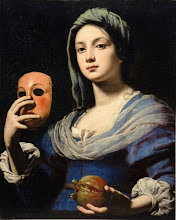A few days ago, for no particular reason, I suddenly thought about the Lebanese poet/painter/philosopher, Kahlil Gibran (a Lebanese friend once told me his surname is pronounced with a soft 'g' in Lebanon, and with a hard 'g' in other parts of the Arabic speaking world). His work had inspired me in my early twenties but I had forgotten about it since then. Now I had a renewed desire to study his paintings closely. When I thought about it I felt that cool, refreshing goose-bump feeling of something serendipitous working out in mysterious ways. To my knowledge his work is not in the collection of any Australian Art Gallery, and the reproductions online are not of the best quality, so it didn't seem very likely "my" wish would be fulfilled.
A couple of days later a friend emailed to let me know about an upcoming exhibition on his work, right here in Sydney where I live!
Kahlil Gibran: The Prophet, The Artist, The Man
This exhibition will introduce audiences to Kahlil Gibran. While many Australians of the baby boomer generation have read The Prophet or heard of Gibran, few know about his life or artworks.
Gibran left Lebanon in 1895 at the age of 12 with his mother and three siblings for a better life in America. Settling in Boston, his early artistic talent was noticed by pictorial photographer F Holland Day of the Boston avant-garde. Gibran gradually developed into a romantic who read widely and drew compulsively.
This exhibition provides an overview of Gibran’s artistic output, featuring oil paintings, works of art on paper — including the original watercolours used as illustrations in the first edition of The Prophet — and writings selected from Gibran’s personal collection at the Gibran Museum in Bsharri, North Lebanon.
Gibran left Lebanon in 1895 at the age of 12 with his mother and three siblings for a better life in America. Settling in Boston, his early artistic talent was noticed by pictorial photographer F Holland Day of the Boston avant-garde. Gibran gradually developed into a romantic who read widely and drew compulsively.
This exhibition provides an overview of Gibran’s artistic output, featuring oil paintings, works of art on paper — including the original watercolours used as illustrations in the first edition of The Prophet — and writings selected from Gibran’s personal collection at the Gibran Museum in Bsharri, North Lebanon.




















No comments:
Post a Comment